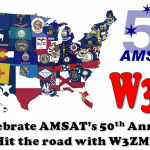AMSAT NEWS SERVICE
ANS-195
The AMSAT News Service bulletins are a free, weekly news and information service of AMSAT North America, The Radio Amateur Satellite Corporation. ANS publishes news related to Amateur Radio in space including reports on the activities of a worldwide group of Amateur Radio operators who share an active interest in designing, building, launching and communicating through analog and digital Amateur Radio satellites.
The news feed on https://amsat.org publishes news of Amateur Radio in space as soon as our volunteers can post it. Please send any amateur satellite news or reports to: ans-editor at amsat dot org. You can sign up for free e-mail delivery of the AMSAT News Service Bulletins via the ANS List; to join this list see: https://www.amsat.org/mailman/listinfo/ans
In this edition:
- 2019 AMSAT Board of Directors Election Ballots Sent
- New Orbitrack iOS app free for Apollo 11 Anniversary
- Help Needed – JAISAT-1 Telemetry
- Changes to AMSAT-NA TLE Distribution for July 11, 2019
- How to Support AMSAT
- Upcoming Satellite Operations
- Satellite Shorts from All Over
The 50th Anniversary AMSAT Space Symposium will be held
October 18-20 in Arlington, VA. For details, see:
https://www.amsat.org/amsat-symposium/
2019 AMSAT Board of Directors Election Ballots Sent
AMSAT members should expect to see ballots for the 2019 AMSAT Board of Directors election arriving in their mailboxes. The ballots have been
sent for printing and will be mailed on or before July 15.
The 2019 AMSAT Board of Directors election will be conducted differently than in past elections. In previous years, the balloting process was handled by multiple vendors. This year, AMSAT has contracted with a single, independent party, ElectionBuddy, to conduct and fully manage the election process.
You may cast your ballot by visiting a unique URL or utilizing the QR code printed on the mailing. You also have the option of returning your paper ballot in the supplied envelope to the AMSAT office. Please do not include any other correspondence in this envelope. It will be opened only by ElectionBuddy. If you do not receive your ballot, you will need to contact ElectionBuddy via email: amsat at electionbuddy.com.
Individual candidates’ statement of qualification (biographies) are displayed on the ElectionBuddy website available to voters and are available on AMSAT’s website: https://www.amsat.org/2019-board-statements/
Because AMSAT has contracted ElectionBuddy for a fully managed election, they will be voters’ single point of contact regarding any ballot issues. The AMSAT Secretary or Office Manager may direct you to contact ElectionBuddy in situations deemed part of this fully managed election. Questions will not be answered on the AMSAT-BB or organizational Social Media accounts.
In the previous election announcement, it was mentioned that voters would have the option to request a special paper ballot. The election process has been modified to eliminate this need. A single mailing has been designed to better accommodate traditional and online voting.
Sincerely,
Clayton L. Coleman, W5PFG
AMSAT Secretary
[ANS thanks AMSAT Secretary Clayton Coleman, W5PFG, for the above information.]
New Orbitrack iOS app free for Apollo 11 Anniversary
On the 50th anniversary of Apollo 11’s first manned moon landing, a new iOS app – Orbitrack – lets you explore the universe of spacecraft in orbit around our home planet today, using cutting-edge augmented and virtual reality technology.
Better yet: for just one day, July 20th, 2019, Orbitrack (normally $4.99) will be offered for free on the iTunes Store.
>From the original developer of the award winning SkySafari™ apps, Orbitrack is the first new release from Southern Stars since 2014. It includes spectacular new graphics, incredibly detailed 3D spacecraft models, fascinating illustrated mission descriptions, and a new database of more than 8,000 satellites updated daily from n2yo.com and celestrak.com.
Orbitrack includes many classified military satellites, and SpaceX’s new Starlink mega-communications-satellite constellation. Both visual and radio observers will appreciate Orbitrack’s up-to-date catalog, which includes frequencies and call signs for amateur radio satellites, and predicts satellite passes and Iridium flares.
Orbitrack’s brand new voice-controlled virtual reality mode works with any iPhone-compatible VR headset. And its rewritten augmented reality (AR) capability lets you identify satellites passing across the sky in real time, using you phone’s GPS, camera, and motion-sensing hardware.
Orbitrack supports the latest Apple hardware and showcases the latest iOS technologies. Southern Stars founder Tim DeBenedictis writes, “When Neil Armstrong walked on the Moon, there were only 159 satellites in orbit. Today, there are well over 40,000. The computing power of the entire lunar module would be dwarfed by today’s smallest cell phones. Offering our latest satellite tracking app for free seemed a good way to celebrate the past, while also looking forward to the future of spaceflight, both manned and unmanned.”
To download Orbitrack for iOS devices from the iTunes Store, follow this link: https://itunes.apple.com/us/app/orbitrack/id1092984911?mt=8
Available today for iOS devices, Orbitrack will be available for Android in the 2nd half of 2019.
[ANS thanks Southern Stars for the above information]
New 2019 AMSAT Apparel Now Available on the Web
Didn’t make it to Hamvention but you want the latest in AMSAT haberdashery?
The new 2019 tee-shirts, polo shirts and hats are now available in the AMSAT online store.
Browse the styles and sizes online and put your order in today at
https://www.amsat.org/product-category/amsat-apparel/
Help Needed – JAISAT-1 Telemetry
JAISAT-1, a 3U CubeSat developed by the Radio Amateur Society of Thailand was launched on July 5, 2019. The satellite carries a VHF/UHF linear transponder for amateur radio use.
The Radio Amateur Society of Thailand (RAST) and the JAISAT-1 Project Teamare urgently seeking raw data that can be received from all packets worldwide. Please send raw data and KSS files to RAST by email at jaisatonetele at gmail.com.
The JAISAT-1 beacon signal is transmitted on 435.700 MHz in GMSK Mobitex 4800 bps mode. Two other satellites on this launch also use
this engineering frequency.
The code for JAISAT-1 frames 1 in row 11 is:
41 (0x29) – JAISAT UHF1
42 (0x2A) – JAISAT UHF2
Example of signals in this format can be found with the the reception of signals from the satellite.
JAISAT-1 has been identified as 2019-038F. TLEs are below:
2019-038F
1 44419U 19038F 19190.66730395 .00001667 00000-0 10000-3 0 9996
2 44419 97.4914 152.5407 0020014 233.1737 126.7422 15.12176922 634
[ANS thanks Tanan Rangseeprom, HS1JAN, JAISAT Project Manager for the above information.]
2019 marks AMSAT’s 50th Anniversary of Keeping Amateur Radio in Space.
To help celebrate, we are sponsoring the AMSAT 50th Anniversary Awards Program.
Full details are available at https://www.amsat.org/amsat-50th-anniversary-awards-program/
Changes to AMSAT-NA TLE Distribution for July 11, 2019
The following Amateur Radio satellites have been removed from this week’s TLE distribution. They are part of the SpaceX Falcon Heavy STP-2 launch of June 25,2019 at 06:30 GMT from launch pad LC-39A at the Kennedy Space Center. They have been identified by Space-Track.
OBJECT B – NORAD CAT ID 44340 – NPSAT1 (Non-Radio Amateur)
OBJECT C – NORAD CAT ID 44341 – OTB (Non-Radio Amateur)
OBJECT E – NORAD CAT ID 44343 – FORMOSAT7-3/COSMIC2-3 (Non-Radio Amateur)
The following Amateur Radio satellite has been added to this week’s TLE distribution.
LightSail-2 – NORAD CAT ID 44420 – Separated from PROX-1, CAT ID 44330
[ANS thanks Ray Hoad, WA5QGD, AMSAT Orbital Elements Manager for the above information.]
Purchase AMSAT gear on our Zazzle storefront. 25% of the purchase
price of each product goes towards Keeping Amateur Radio in Space
https://www.zazzle.com/amsat_gear
How to Support AMSAT
AMSAT relies on the support of our members and the amateur radio community to Keep Amateur Radio in Space. How can you help?
- Join AMSAT
Both you and AMSAT will benefit when you join. You get the AMSAT Journal bimonthly and support from AMSAT Ambassadors. Member dues and donations provide AMSAT’s primary support. Join today at https://www.amsat.org/product-category/amsat-membership/ - Become a Life Member
Becoming a Life Member has never been easier. Now you can become a Life Member with 12 monthly payments of $74 through our online store. See https://www.amsat.org/product/lifetime-membership/ for details. - Donate to AMSAT
Make a one time or recurring donation to AMSAT today. Even as little as one dollar a month can make a difference! Donate today at https://www.amsat.org/donate/ - Purchase AMSAT gear on our Zazzle storefront.
AMSAT receives 25% of the price of each sale on AMSAT logo merchandise from our Zazzle storefront located at https://www.zazzle.com/amsat_gear - Support AMSAT when you make purchases from Amazon!
So far, AMSAT has received $3,913.29 from AmazonSmile. Search for “Radio Amateur Satellite Corporation” https://smile.amazon.com/ref=smi_ext_twt_dshb_smi - Volunteer for AMSAT
AMSAT relies on volunteers for nearly all of our activities. If you have an idea for how to help, please let us know, Details on
volunteering can be found at https://www.amsat.org/volunteer-for-amsat/
[ANS thanks the AMSAT office for the above information.]
AMSAT and ARISS are currently supporting a FundRazr campaign to raise
$150,000 for critical radio infrastructure upgrades on ISS. The upgrades are
necessary to enable students to continue to talk to astronauts in space via
Amateur Radio. We have reached a great milestone with $33,250 raised or about
17% towards our goal. This would not have been possible without your
outstanding generosity!!
For more information and to DONATE TODAY visit:
https://fundrazr.com/arissnextgen?ref=ab_e7Htwa_ab_47IcJ9
Upcoming Satellite Operations
- Iceland (HP93, HP94, HP95, IP03, IP05, IP13, IP14, IP15, IP24, IP25, IP35) – July 13-19, 2019
Adam, K0FFY, is taking his family (and his radios) to Iceland. He’ll be staying in HP95 on July 13, IP15 on July 14-15, IP25 on July 16, IP03 on July 17-18, and HP94 on July 19. In total, he’ll be passing through HP93, HP94, HP95, IP03, IP05, IP13, IP14, IP15, IP24, IP25, IP35. There’s a lot to see, so passes will be best effort & announced on Twitter shortly prior. https://twitter.com/K0FFY_Radio - CY9 St. Paul Island (FN97) – July 31 to August 8, 2019
CY9C will be on St. Paul Island July 31st through August 8th. This is an all bands/mode dxpedition, with EME and Sats as well. More info available at http://cy9c.com/index.html - Washington Invasion (CN96/96 & DN06/07/17/17) – August 9-10, 2019
Casey, KI7UNJ, will be heading North to invade the State of Washington, August 9th and 10th. Keep an eye on Casey’s Twitter feed for specific pass announcements: https://twitter.com/KI7UNJ - St Pierre et Miquelon (GN16) – August 10-18, 2019
A DXpedition is planned to St Pierre et Miquelon, August 10th through the 18th. The team will operate as T05M will from Ile aux Marins on 6-160m, but there is a possibility of some FM Satellites. Keep an eye on their website for updates: http://fp2019.net/ - Santa Rosa Island, CA (CM93) – August 12-14, 2019
Ron, AD0DX, is heading back to Santa Rosa Island, August 12th -14th. When not distracted by the feathered-birds, Ron will be on FM and linear satellites as W6R. Keep an eye on Ron’s Twitter feed for updates at the dates get closer. https://twitter.com/ad0dx
Remember to check out W3ZM On the Road for additional upcoming activations! https://www.amsat.org/events/was-w3zm/
[ANS thanks Robert Bankston, KE4AL, for the above information.]
AMSAT, along with our ARISS partners, is developing an amateur radio package,
including two-way communication capability, to be carried on-board Gateway in lunar orbit.
Support AMSAT’s projects today at https://www.amsat.org/donate/
Satellite Shorts from All Over
- FO-29 has been offline since approximately 22:00 UTC on July 9th. The amateur satellite community awaits word from the satellite’s operator, JARL, on the situation.
- AMSAT Operations activated the Virginia Tech Camera on AO-92 on July 10th and July 11th in support of the ARRL Teachers Institute. Images
captured can be found at http://www.amsat.org/tlm/showImages.php?id=4 - AMSAT Operations reports that AO-85 is shutting down each eclipse. The satellite turns on several minutes after entering sunlight, when voltages reach adequate levels to operate the satellite hardware.
- Virgin Orbit conducted a successful drop test of LauncherOne on July 10th. This was the final test prior to the first test flight of the new air launch system. AMSAT’s RadFxSat-2 / Fox-1E is scheduled to fly on the second launch of the LauncherOne, as early as late this summer. Details on the test can be found at: https://tinyurl.com/ANS-195-VO
- The AMSAT Board of Directors meeting minutes page was updated with recent minutes.
https://www.amsat.org/minutes-of-the-board-of-directors/ - AMSAT financial audit/review reports and IRS Form 990 filings can be found at
https://www.amsat.org/audit-and-other-financial-reports/ - EA4GPZ’s blog contains several updates on images captured by LO-94. See https://destevez.net/ for details.
- This week’s Flashback Friday Tweet from @AMSAT: https://twitter.com/AMSAT/status/1149667412779786240 In the late 1970s, the AMSAT-GOLEM-80 Microcomputer Project was designed as a low-cost and expandable Z80 or 8080 based microcomputer for amateur radio applications. Details can be found in the Sept 1979 issue of Byte Magazine. https://archive.org/details/byte-magazine-1979-09/page/n183
In addition to regular membership, AMSAT offers membership in the President’s Club. Members of the President’s Club, as sustaining donors to AMSAT Project Funds, will be eligible to receive additional benefits. Application forms are available from the AMSAT office.
Primary and secondary school students are eligible for membership at one-half the standard yearly rate. Post-secondary school students enrolled in at least half time status shall be eligible for the student rate for a maximum of six post-secondary years in this status. Contact Martha at the AMSAT office for additional student membership information.
73 and Remember to help keep amateur radio in space,
This week’s ANS Editor,
Paul Stoetzer, N8HM
n8hm at amsat dot org




